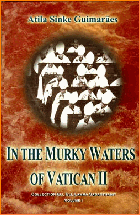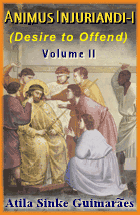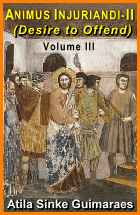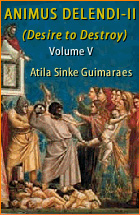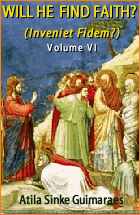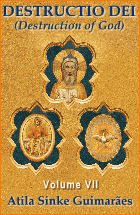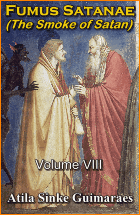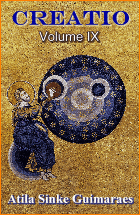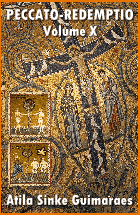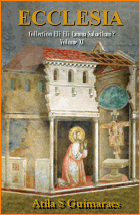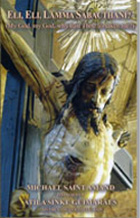NEWS: November 3, 2025
 |
 |
 |
 |
 |
 |
 |
Bird’s Eye View of the News

ONE CATHEDRA FOR THE TRUTH & ANOTHER FOR HERESY –
We have seen Pope Leo XIV establish a throne for King Charles III on the apse of St. Paul Outside-the-Walls Basilica on October 23. Since Charles is also the head of the so-called Anglican Church, that symbolic act takes on added significance. Today, I want to analyze its meaning. But to do so, I need to establish some presuppositions.
First, in his Encyclical Apostolicae curae of September 18, 1896, Leo XIII using his papal authority demonstrated quite clearly that the orders or sacraments in the so-called Anglican Church are not valid. This is tantamount to saying that the Anglican bishops did not sustain the Apostolic Succession. The immediate consequence of such invalidity is that the “bishops” do not have power to consecrate other bishops or priests or to administer true sacraments.
If this is so, the “Anglican Church” is a façade; it has the appearance of a Church but it is not. It is an institution where the English go to assist at some ceremonies in a recollected ambience, listen to nice music and pious sermons. It is essentially an English club. However, since it insists on being considered a religion, before the Catholic Church it is a false religion. Charles III is the head of this club or false religion.
/bev310_Hen.jpg) Second, in the 16th century Henry VIII broke with the Catholic Church because Pope Clement VII would not annul his marriage with Catherine of Aragon. For this reason, he rebelled against the Pope, declared himself to be head of the Church of England, divorced his legitimate wife and then “married” Anne Boleyn. He seized all the properties of the Catholic Church, and persecuted and executed Catholics who did not accept him as head of his new church. Although during the time of Henry VIII England was still not fully Protestant, it became formally so under the kingdoms of Edward VI and Elizabeth I. Charles III represents this Protestant heritage.
Second, in the 16th century Henry VIII broke with the Catholic Church because Pope Clement VII would not annul his marriage with Catherine of Aragon. For this reason, he rebelled against the Pope, declared himself to be head of the Church of England, divorced his legitimate wife and then “married” Anne Boleyn. He seized all the properties of the Catholic Church, and persecuted and executed Catholics who did not accept him as head of his new church. Although during the time of Henry VIII England was still not fully Protestant, it became formally so under the kingdoms of Edward VI and Elizabeth I. Charles III represents this Protestant heritage.
Since the denial of a divorce was the cause of the rupture and the Catholic Church has never changed her doctrinal position on divorce, there is no possible agreement between Catholics and Anglicans.
Now then, when he was Prince of Wales Charles III divorced Princess Diana. After she died, he married a divorced woman – the present day Queen Camilla. Therefore, the honor Leo XIV conferred upon Charles – giving him a throne on the apse of that Basilica – was a de facto acceptation of the divorce and a denial of the doctrine of the Church on this topic.
/bev310_Tr1.jpg)
/bev310_Tr2.jpg) Third, the throne given to Charles was not a temporary ceremonial decision made just for that occasion, as many could imagine. It was explicitly meant to be a permanent throne for the King of England and his heirs and successors to use whenever they will be in Rome. In other words: It is a throne established forever. This permanent character of the initiative can be verified indisputably in the
newsletter of the Vatican, the commentaries of Card. Vincent Nichols, Archbishop of Westminster and Primate of England, and the dispatches of
The Times of London and the
Independent Catholic News.
Third, the throne given to Charles was not a temporary ceremonial decision made just for that occasion, as many could imagine. It was explicitly meant to be a permanent throne for the King of England and his heirs and successors to use whenever they will be in Rome. In other words: It is a throne established forever. This permanent character of the initiative can be verified indisputably in the
newsletter of the Vatican, the commentaries of Card. Vincent Nichols, Archbishop of Westminster and Primate of England, and the dispatches of
The Times of London and the
Independent Catholic News.
Having made these three presuppositions, I am now in conditions to analyze some symbolic aspects of that event.
Charles entered the Basilica while the organ and the choir performed the hymn Hosanna Filio David, which was the glorification the Jews gave to Our Lord Jesus Christ when He entered Jerusalem in triumph on Palm Sunday. Now then, to have chosen this hymn to receive the divorced head of a Protestant Sect that denies many dogmas of the Catholic Faith and has killed thousands of Catholics was highly offensive to all Catholics, especially to the Catholic Monarchs in History who actually deserved this honor.
Soon after he entered the presbytery of the Basilica, Charles was directed to seat himself on the throne that had been made especially for him. To justify this action, the two main representatives of the Pope – Card. James Harvey and Abbot Donato Ogliari – recalled that the Basilica had an old tradition linked to England. It was from its monks that St. Gregory the Great chose a delegation of apostles led by St. Augustine of Canterbury to evangelize England. Because of this fact the medieval Kings of England exercised the symbolic role of Defenders of that Basilica.
Although this was a beautiful tradition, it was completely broken when Henry VIII declared himself the head of the Church of England and seized all the Church properties. He became not the Defender of the Church but her Usurper. To try to annul almost five centuries of hostilities and persecutions by unilaterally granting honors to a heretic is more than a diplomatic mistake, it is an obvious sign of complicity with heresy.
The principal goal of the event was to confer upon Charles the title of Regalis Confrater – Royal Brother – which was done by Abbot Donato Ogliari, Abbot of St. Paul Outside-the-Walls Monastery. By declaring the head of the Anglican Sect a brother, the Conciliar Church declared itself in full affinity with Caesaropapism – the church should be controlled by the civil authority – divorce, women priests and bishops, as well as the heresies professed by the Anglicans regarding the Mass, the Holy Eucharist, Mariology and the Pope.
/bev310_Bur.jpg) Now, let me turn the page and say a word about another ceremony that took place two days later at St. Peter’s Basilica in front of the altar of the Cathedra of Peter, the Throne of Peter. On that Altar there is a Chair, a Throne, a Cathedra used by St. Peter when he was alive. It is situated over that Altar as a precious Relic and surrounded by a splendorous baroque ornamentation known as “the glory of Bernini.” When Catholics say that the Pope teaches a doctrine “ex Cathedra,” we refer to that Chair to say that the Pope speaks with the full authority of the Apostle Peter, and for this reason that teaching becomes infallible.
Now, let me turn the page and say a word about another ceremony that took place two days later at St. Peter’s Basilica in front of the altar of the Cathedra of Peter, the Throne of Peter. On that Altar there is a Chair, a Throne, a Cathedra used by St. Peter when he was alive. It is situated over that Altar as a precious Relic and surrounded by a splendorous baroque ornamentation known as “the glory of Bernini.” When Catholics say that the Pope teaches a doctrine “ex Cathedra,” we refer to that Chair to say that the Pope speaks with the full authority of the Apostle Peter, and for this reason that teaching becomes infallible.
Leo XIV gave the Altar of the Cathedra of Peter to Card. Raymond Burke to say the first solemn Mass according to the Missal of 1962 of his pontificate. That ceremony took place on October 25, only two days after Charles received his throne at St. Paul’s Basilica.
So, here is the irony of the “coincidence:” Two days before that a glorification of the Cathedra of Truth was made in St. Peter’s Basilica, a Cathedra of Heresy had been established in St. Paul’s Basilica…

First, in his Encyclical Apostolicae curae of September 18, 1896, Leo XIII using his papal authority demonstrated quite clearly that the orders or sacraments in the so-called Anglican Church are not valid. This is tantamount to saying that the Anglican bishops did not sustain the Apostolic Succession. The immediate consequence of such invalidity is that the “bishops” do not have power to consecrate other bishops or priests or to administer true sacraments.
If this is so, the “Anglican Church” is a façade; it has the appearance of a Church but it is not. It is an institution where the English go to assist at some ceremonies in a recollected ambience, listen to nice music and pious sermons. It is essentially an English club. However, since it insists on being considered a religion, before the Catholic Church it is a false religion. Charles III is the head of this club or false religion.
/bev310_Hen.jpg)
Hundreds of Catholics were martyred for not accepting Henry VIII as head of the Church
Since the denial of a divorce was the cause of the rupture and the Catholic Church has never changed her doctrinal position on divorce, there is no possible agreement between Catholics and Anglicans.
Now then, when he was Prince of Wales Charles III divorced Princess Diana. After she died, he married a divorced woman – the present day Queen Camilla. Therefore, the honor Leo XIV conferred upon Charles – giving him a throne on the apse of that Basilica – was a de facto acceptation of the divorce and a denial of the doctrine of the Church on this topic.
/bev310_Tr1.jpg)
Above, Abbot Ogliari presents to Charles his throne at the apse of St. Paul’s Basilica; below, a frontal view
/bev310_Tr2.jpg)
Having made these three presuppositions, I am now in conditions to analyze some symbolic aspects of that event.
Charles entered the Basilica while the organ and the choir performed the hymn Hosanna Filio David, which was the glorification the Jews gave to Our Lord Jesus Christ when He entered Jerusalem in triumph on Palm Sunday. Now then, to have chosen this hymn to receive the divorced head of a Protestant Sect that denies many dogmas of the Catholic Faith and has killed thousands of Catholics was highly offensive to all Catholics, especially to the Catholic Monarchs in History who actually deserved this honor.
Soon after he entered the presbytery of the Basilica, Charles was directed to seat himself on the throne that had been made especially for him. To justify this action, the two main representatives of the Pope – Card. James Harvey and Abbot Donato Ogliari – recalled that the Basilica had an old tradition linked to England. It was from its monks that St. Gregory the Great chose a delegation of apostles led by St. Augustine of Canterbury to evangelize England. Because of this fact the medieval Kings of England exercised the symbolic role of Defenders of that Basilica.
Although this was a beautiful tradition, it was completely broken when Henry VIII declared himself the head of the Church of England and seized all the Church properties. He became not the Defender of the Church but her Usurper. To try to annul almost five centuries of hostilities and persecutions by unilaterally granting honors to a heretic is more than a diplomatic mistake, it is an obvious sign of complicity with heresy.
The principal goal of the event was to confer upon Charles the title of Regalis Confrater – Royal Brother – which was done by Abbot Donato Ogliari, Abbot of St. Paul Outside-the-Walls Monastery. By declaring the head of the Anglican Sect a brother, the Conciliar Church declared itself in full affinity with Caesaropapism – the church should be controlled by the civil authority – divorce, women priests and bishops, as well as the heresies professed by the Anglicans regarding the Mass, the Holy Eucharist, Mariology and the Pope.
/bev310_Bur.jpg)
Card. Burke says Mass at the Cathedra of Peter Altar
Leo XIV gave the Altar of the Cathedra of Peter to Card. Raymond Burke to say the first solemn Mass according to the Missal of 1962 of his pontificate. That ceremony took place on October 25, only two days after Charles received his throne at St. Paul’s Basilica.
So, here is the irony of the “coincidence:” Two days before that a glorification of the Cathedra of Truth was made in St. Peter’s Basilica, a Cathedra of Heresy had been established in St. Paul’s Basilica…





